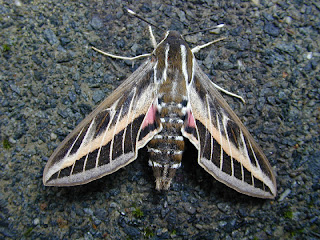A brief history of moths in the garden
As I am about to embark on another season of moth recording in the garden, I thought it might be worth mentioning what has gone before...
We moved into our current house in Banstead, (just outside of the Greater London boundary in north Surrey), in August 1987. The garden is 90 foot long and of a typical 1930s semi-detached house. There is a mature ash tree, a couple of large conifers and, to my shame, mostly non-native planting. I then owned an actinic moth trap which I ran on practically a nightly basis, with only snow, ice and winds above force 6 postponing the ceremonial switch on. I identified and counted everything - identified what I could, that is. Specimens that I struggled with were packed off to Graham Collins, the county moth recorder.
In January 1990 I took the plunge and acquired an MV trap. My counts and range of species subsequently rocketed. By 1996 (a spectacular moth year) I stopped counting everything and contented myself in sifting through the catch and noting what was irregular. In some ways I wish I'd carried on, as I had 10 years of complete, comparable data that would now be coming up to 25 years worth.
From the late 1990s the trap went out less frequently, maybe 2-3 times a week. In recent years I've experienced fits of enthusiasm and troughs of indifference. However, I've kept recording.
So far, the garden list stands on 385 species of macro moths. During those 24 years, I have seen the fluctuations of certain species first hand. The first Red-green Carpet that I trapped in 1990 was only the fourth Surrey record in 20 years - it is now hardly worth noting. Cypress Pug and Toadflax Brocade have also gone from being garden (and county) rarities to become expected trap visitors. The march northwards of Orange, Buff and Dingy Footmans can be seen first-hand. There are losses - I rarely see Garden Tigers, Eyed Hawk-moths and Red Underwings now, where as I used to. Sadly, there are plenty more that I could mention.
Migrants do crop up from time to time. Along with many Silver Y, lesser numbers of Dark-sword Grass and even fewer Pearly Underwing I have been graced with Bordered Straw (15), Scarce Bordered Straw (5), Hummingbird Hawk-moth (several), Gem, Vestal, Small Mottled Willow and, best of all, single Blair's Mocha and Striped Hawk-moth (pictured above - any excuse to show this beast again!).
The odd species turns up that has me scratching my head - where have the three Festoons come from? Or the handful of usually aquatic reliant Wainscots?
Being on chalk does mean that I am well off for a good selection of species. Best night catches usually number 500-800, but such numbers are rather rare. I might record 50-75 species of macro on such a night. One thing is a constant, and that is that no one year resembles another. It keeps me going!



Comments